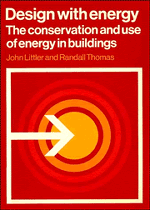Book contents
- Frontmatter
- Contents
- Units, symbols, abbreviations, conventions and conversion factors
- Preface
- 1 Energy and buildings
- 2 Site planning and analysis
- 3 Building design
- 4 Passive solar design
- 5 Active solar heating
- 6 Space heating and ventilation
- 7 Thermal storage
- 8 Wind energy
- 9 Water-supply systems
- 10 Waste disposal and utilization
- 11 Domestic-energy saving
- 12 Housing case studies
- 13 Non-domestic case studies
- Appendix 1 Weather data
- Appendix 2 Thermal performance
- Appendix 3 Interstitial condensation
- Index
1 - Energy and buildings
Published online by Cambridge University Press: 03 February 2010
- Frontmatter
- Contents
- Units, symbols, abbreviations, conventions and conversion factors
- Preface
- 1 Energy and buildings
- 2 Site planning and analysis
- 3 Building design
- 4 Passive solar design
- 5 Active solar heating
- 6 Space heating and ventilation
- 7 Thermal storage
- 8 Wind energy
- 9 Water-supply systems
- 10 Waste disposal and utilization
- 11 Domestic-energy saving
- 12 Housing case studies
- 13 Non-domestic case studies
- Appendix 1 Weather data
- Appendix 2 Thermal performance
- Appendix 3 Interstitial condensation
- Index
Summary
Introduction
Forecasting is an art in which all are likely to be wrong but some will be more wrong than others. We expect the next few years to be a time for reflection. A variety of opinions on the conservation and use of energy in buildings now exists and a limited amount of data is available. Economic recession has increased the pressure on public and private funds; and the lack of national, let alone global, strategies for resource development has hindered development of energy conservation projects and the exploitation of alternative sources of energy. The result is an atmosphere of caution which at its worst could result in inactivity and resignation and at its best could lead to significant, if somewhat restrained, progress in the use and conservation of energy in the built environment. This may have to be enough – building, after all, is another art of the possible.
Our approach in this book has been to provide designers with a systematic framework for considering the use of energy in buildings. We have tried to cover the more important of the wide variety of topics that must be considered and to provide sufficient references to allow the reader to pursue points of particular interest in depth. A great deal of information has been produced during the last few years but virtually no overviews exist. Different research groups work independently of each other and often work with different aims in view. The overall result is a jungle of papers, data, evaluations and opinions for which we have tried to offer a guide.
- Type
- Chapter
- Information
- Design with EnergyThe Conservation and Use of Energy in Buildings, pp. 1 - 13Publisher: Cambridge University PressPrint publication year: 1984



